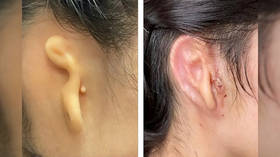Woman receives 3D printed ear transplant

A 20-year-old woman has reportedly become the first patient to undergo a successful ear transplant using a 3D-printing-based technology which allowed medics to use the patient's own cells to grow the implant.
As reported by the New York Times, the woman, who is only referred to as Alexa from Mexico, was born with a rare birth defect that caused the outer part of her right ear to grow small and misshapen.
Dr. Arturo Bonilla, a pediatric ear reconstructive surgeon in San Antonio, Texas who performed the operation, began by removing half a gram of cartilage from Alexa’s ear and making a 3D scan of her healthy left ear, the Times wrote. He then sent this material to 3DBio Therapeutics, a company based in Queens, New York that specializes in regenerative medicine.
3DBio used the tissue sample to grow billions of cells that were then mixed with the company’s collagen-based ink, which was inserted into a specialized 3D bio-printer to create a mirror replica of the patient’s healthy ear. The whole process reportedly took less than 10 minutes.
The printed ear was then shipped overnight in cold storage to Dr. Bonilla, who implanted the ear under Alexa’s skin, just above her jawbone. The operation took place in March, and 3DBio says that the ear will continue to regenerate cartilage tissue until it eventually has the look and feel of a natural ear.
Alexa has reportedly stated that she is excited about the new ear, even though it has not yet fully developed. She said that when she was little she was never bothered by her ear, but as she came into her teenage years she started growing more self-conscious about her appearance.
"You care a little more for your image when you're a teenager. Some people said things that were not thoughtful, and it started bothering me,” she said, adding that she has gotten used to covering up her right ear by wearing her hair long and loose.
But thanks to the surgery, Alexa says she thinks her self-esteem will improve, and she looks forward to being able to wear her hair in a ponytail or bun.
The results of Alexa’s reconstructive surgery were announced by 3DBio in a news release on its website. The company is taking part in an ongoing clinical trial to assess the effectiveness of such technology.
The trial is said to include 11 patients, and it is still possible that the transplants could fail or bring unanticipated health complications. However, since the cells used for the printing originate from the patients themselves, doctors and 3DBio officials say it is unlikely that the tissue would be rejected by the body.














